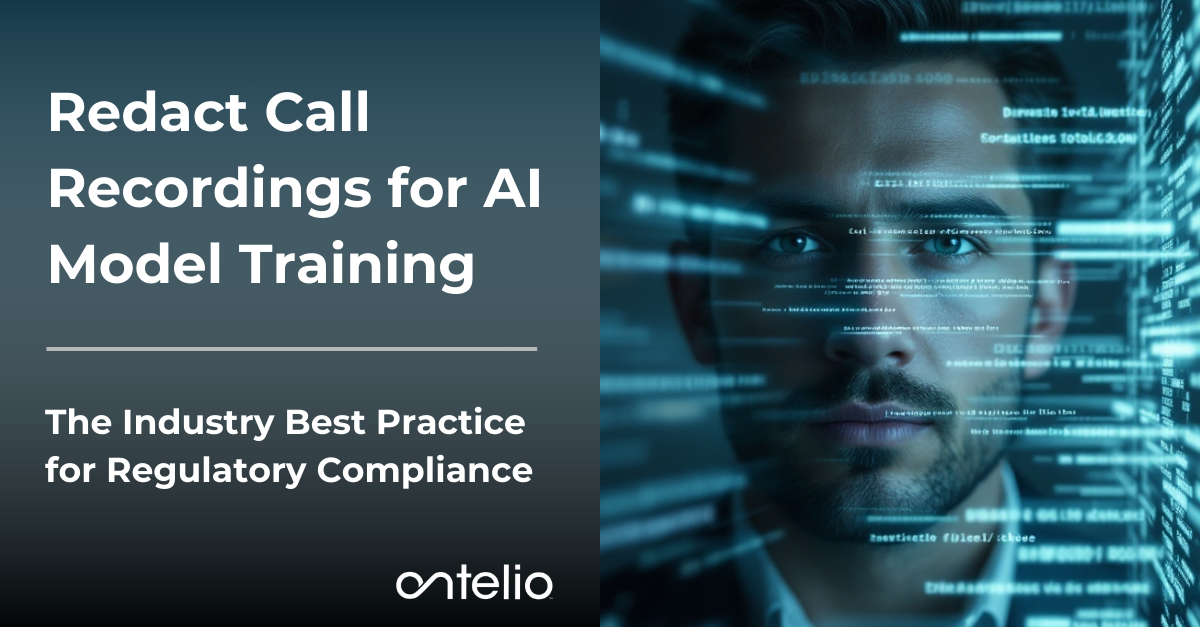Maximizing ROI for Regulatory Compliance and AI Model Training
Today organizations face constant pressure to safeguard customer information while navigating a maze of regulatory requirements. Compliance is not...
5 min read
Marcel Fournier Oct 17, 2024 10:10:41 AM

In the age of AI and data-driven insights, businesses face the dual challenge of leveraging vast amounts of data for customer experience (CX) optimization while ensuring compliance with stringent data privacy regulations. For organizations that operate contact centers, such as those in healthcare, finance, and e-commerce, regulatory compliance around data handling is non-negotiable. One effective strategy emerging as an industry best practice is using redacted call recordings for AI model training after transcription. This approach ensures compliance with regulations such as GDPR, CCPA, HIPAA, and PCI-DSS while maintaining the valuable insights that these interactions offer.
Artificial intelligence is playing an increasingly central role in transforming customer experience. Contact centers, which handle billions of customer interactions annually, rely on AI to improve operational efficiency, deliver personalized customer service, and provide predictive insights. AI models are crucial for analyzing customer behavior, automating routine tasks, and even predicting future trends. However, training these AI models requires large datasets, often sourced from customer interactions such as call recordings, chat logs, and emails.
These datasets typically contain sensitive information, including personally identifiable information (PII), payment card information (PCI), and protected health information (PHI). Without proper safeguards, organizations can face severe penalties for non-compliance with data privacy laws, not to mention the risk of reputational damage and customer mistrust. Data breaches are on the rise, and regulatory bodies are imposing stricter fines and penalties on organizations that fail to protect sensitive information.
To mitigate these risks, companies are increasingly turning to redaction techniques that enable them to continue leveraging customer data while ensuring privacy and compliance. AI-powered redaction can remove or mask sensitive information before data is used for training machine learning models, ensuring that organizations comply with global regulations while still utilizing the valuable insights available in customer interactions.
Redaction is the process of selectively removing or masking sensitive information within data to prevent unauthorized access. In AI model training, using redacted call recordings and transcripts allows organizations to strike a balance between data utility and privacy. By ensuring that sensitive data such as customer names, addresses, credit card numbers, and health details are redacted, organizations can harness the full power of AI without exposing themselves to legal and financial risks.
The challenge with traditional redaction methods is that they often rely on pattern-matching techniques, which are prone to both over-redaction (removing too much useful information) and under-redaction (leaving sensitive data unprotected). AI-driven redaction tools, however, utilize advanced natural language processing (NLP) and machine learning (ML) techniques to ensure that redaction is both precise and contextually accurate.
Redacting data before AI training is critical for compliance with various privacy regulations. Laws like GDPR (General Data Protection Regulation), HIPAA (Health Insurance Portability and Accountability Act), CCPA (California Consumer Privacy Act), and PCI-DSS (Payment Card Industry Data Security Standard) all mandate strict data handling protocols, particularly when it comes to the use of personal data for analytics and machine learning purposes. For example, GDPR enforces stringent rules about how personal data can be used, especially for AI-based analytics, making data anonymization or redaction mandatory.
Compliance frameworks require organizations to demonstrate that they have implemented adequate safeguards to protect sensitive data during processing and analysis. By redacting sensitive information before using it to train AI models, organizations can confidently meet audit requirements and avoid significant fines, such as the €20 million or 4% of global turnover imposed under GDPR for non-compliance.
Data breaches can have devastating consequences, including financial penalties, legal action, and reputational damage. The average cost of a data breach has skyrocketed, particularly in sectors like healthcare, where breaches can cost over $10 million on average. Redacted data ensures that even in the event of a breach, sensitive information such as credit card numbers or medical history remains protected, as it has already been removed or anonymized. This drastically reduces the potential impact of the breach on customers and the organization.
Moreover, redacting call recordings before training AI models adds an extra layer of security. AI models trained on redacted data are far less likely to expose sensitive details in future analyses, making this practice an essential part of a comprehensive data security strategy.
While traditional redaction methods involve manual processes or simple keyword matching, modern AI-powered redaction tools offer a level of precision and efficiency that is unparalleled. These tools use sophisticated algorithms to automatically identify sensitive information across multiple formats—such as voice calls, chat logs, and emails—and redact it with minimal human intervention. This ensures that organizations can meet compliance requirements while maintaining operational efficiency.
Ontelio’s multi-stage redaction engine, for example, leverages context-aware AI to accurately identify and redact PII, PCI, and PHI from contact center data. This solution is designed to handle the complexities of contact center operations, where customer interactions often contain a mixture of structured and unstructured data. The AI is capable of processing large volumes of data in near-real time, ensuring that sensitive information is protected immediately after the interaction is captured.
Key features of AI-powered redaction include:
One of the most significant challenges global organizations face is adhering to data protection laws across different regions. Privacy regulations can vary significantly from one country to another, with laws such as GDPR in Europe, HIPAA in the U.S., PIPEDA in Canada, and LGPD in Brazil each imposing unique requirements.
Ontelio’s redaction engine is specifically designed to support global compliance efforts by adhering to multiple regulatory frameworks simultaneously. This ensures that data is processed according to the specific laws of each region, allowing companies to operate seamlessly across borders. By using multilingual support and localized redaction features, companies can ensure compliance even when working with data in multiple languages and jurisdictions.
This capability is particularly valuable for industries like finance, healthcare, and e-commerce, where businesses must protect sensitive data while operating in multiple regulatory environments. By automating redaction and dynamically updating to reflect changes in regulations, AI-driven redaction tools can help businesses stay ahead of evolving legal requirements.
While data privacy is a primary concern, companies still need to extract valuable insights from their data to optimize their operations and improve customer experiences. One of the biggest advantages of using redacted data for AI training is that it enables data minimization without sacrificing the quality of the insights. By removing only the sensitive data and retaining the context, AI models can still learn from patterns, behaviors, and trends present in the data.
For example, contact centers can use redacted data to train AI models that improve customer sentiment analysis, intent recognition, and predictive analytics. These models can help agents respond more effectively to customer queries, identify potential issues before they escalate, and deliver a more personalized customer experience. Additionally, by adhering to the principle of data minimization, companies can reduce the risk of data breaches while still harnessing the full potential of their data.
As AI becomes more integral to the customer experience, the ability to use data ethically and securely is becoming a key competitive differentiator. By adopting best practices such as redacting call recordings for AI model training, businesses can not only ensure regulatory compliance but also foster trust among their customers. Implementing AI-powered redaction solutions ensures that sensitive data is protected, while also maximizing the value that businesses can derive from their customer interactions.
For industries where compliance and data privacy are critical—such as healthcare, finance, and retail—using redacted data for AI model training is rapidly becoming a necessity. By protecting sensitive information while still leveraging the power of AI, businesses can stay ahead of the competition, avoid costly data breaches, and build a reputation for being both innovative and responsible.

Today organizations face constant pressure to safeguard customer information while navigating a maze of regulatory requirements. Compliance is not...

The rise of AI voice-cloning technology has introduced new challenges for cybersecurity, leaving financial institutions and consumers vulnerable to...

4 min read
In today's business landscape, marked by an increasingly data-centric approach, the role of the contact center has evolved into a pivotal bridge...